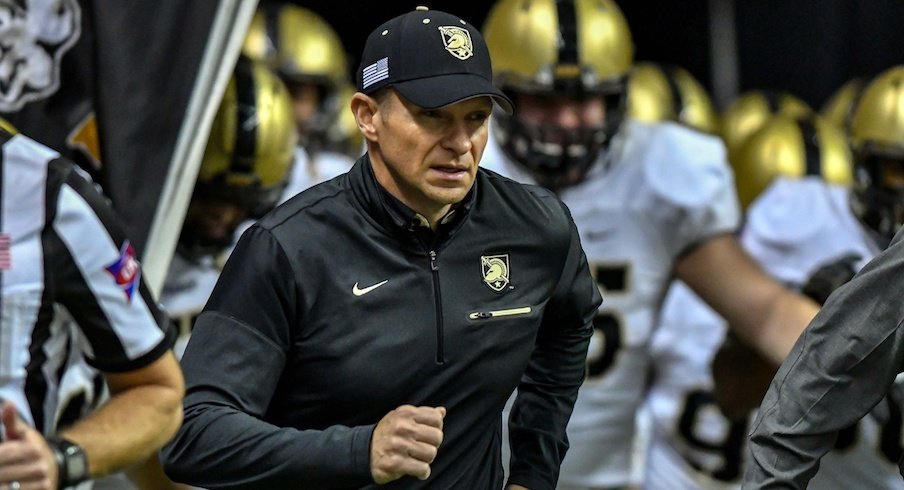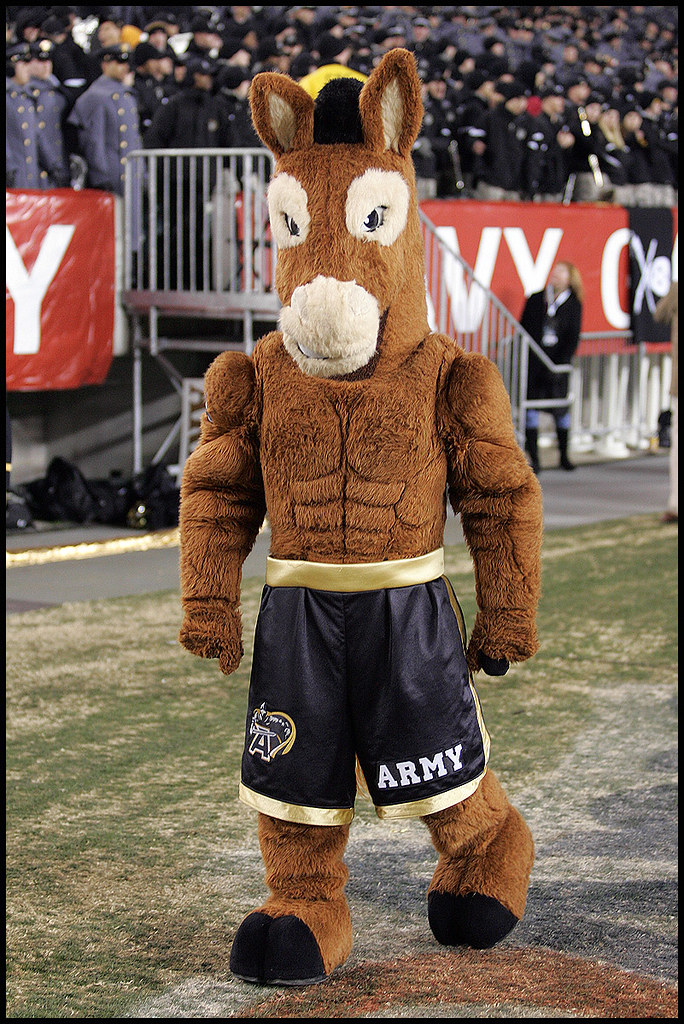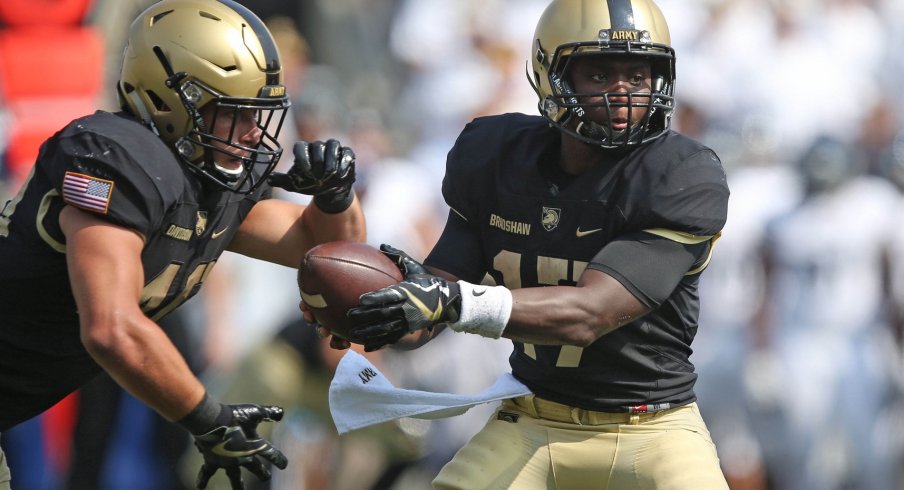ScriptOhio
Everybody is somebody else's weirdo.
2017 LOOK AHEAD: ARMY AT OHIO STATE

Urban Meyer and Ohio State do everything they can to not only show their respect but promote the terrific men and women of the United States Armed Forces across social media and to their football players. But the head football coach probably isn't too happy to see one on the schedule this fall.
“Best thing about this game is we won it. It's in the rear view mirror,” Meyer said nearly three years ago after Ohio State pulled away from Navy, 34-17, in J.T. Barrett's first career start. “It seemed like we've been working on this thing forever.”
The trip to Baltimore and defeat of the Midshipmen came in Week 1 of the 2014 season. Navy runs a triple option offense, a difficult thing to prepare for and even harder offense to defend. The next week, Virginia Tech's 46 Bear defense shocked the Buckeyes and the college football world as the Hokies upset Ohio State 35-21 in Columbus.
While that season ended with Meyer and Co. lifting the national championship trophy, their next one also has a matchup with a service academy waiting. The Army Black Knights, who also run a version of the triple option, are scheduled to visit Columbus in Week 3 on Sept. 16 at 4:30 p.m.
Ohio State plays UNLV — who went 4-8 last season — the week after it hosts Army. All due respect to the Rebels, they are not on the same level as an ACC school like Virginia Tech. But the Buckeyes might have their hands full against Army, even though head coach Jeff Monken's roster is filled with two- and three-star recruits.
Army beat Navy last season for the first time in the last 15 years of that storied rivalry. It also made its first appearance in a bowl game since 2010. The Black Knights surged past North Texas 38-31 in overtime to win the Heart of Dallas Bowl.
Monken enters his fourth year at the helm of the program coming off his first winning season and sporting a 14-23 overall record. Let's get to know Army a bit more.
OFFENSE
Because the Black Knights are independent, we obviously cannot compare their statistics to other teams in their respective conference. We can, however, look at how much production walked out the door due to graduation.
The biggest piece that is no longer around for Monken on offense is 2016 leading receiver, Edgar Poe. In case you don't make it a point to annually watch the Army-Navy game (you should) you might not know Poe's story.
ARMY FILE
Head Coach Jeff Monken (4th season, 14-23 record at Army)
2016 Record 8-5, beat Navy for the first time since 2001
2016 Postseason Beat North Texas 38-31 in overtime in the Heart of Dallas Bowl
Biggest Losses WR Edgar Poe, LBs Jeremy Timpf and Andrew King, RG Justin Gilbert
Biggest Returnees QB Ahmad Bradshaw, RB Andy Davidson, LB Alex Aukerman
Summary Army's triple option gives defenses fits. Is it enough to pull an upset?
Matchup Sept. 16, 2017: Army at Ohio State, kickoff at 4:30 p.m. on FOX
His middle name is Allen, so yes, his full name is Edgar Allen Poe, like the famous poet. That poet, however, spelled his middle name, Allan. Army's Poe fittingly said last year that he loves poetry and led the Black Knights in receiving for the third straight season. That only amounted to 16 catches for 336 yards and three touchdowns but in an offense that averaged only 7.6 pass attempts per game, his exit leaves a considerable hole.
Quarterback Ahmad Bradshaw (not the one who won two Super Bowls with the New York Giants) returns for his senior season and trying to improve on a 44 percent completion rate from 2016. He threw only four touchdowns and was picked off nine times and tallied 703 total yards through the air.
Monken mixed and matched his quarterback situation often in 2016 — five different players took snaps and all of them appeared in at least nine games. As a whole, the Black Knights finished with seven touchdown passes and 11 interceptions. The second-most passing yards came from junior Chris Carter, who finished with 176.
Entire article: http://www.elevenwarriors.com/ohio-...r-first-time-ever-on-sept-16-at-the-horseshoe

Go Bucks...Beat "the mule" (or whatever it is)......

Urban Meyer and Ohio State do everything they can to not only show their respect but promote the terrific men and women of the United States Armed Forces across social media and to their football players. But the head football coach probably isn't too happy to see one on the schedule this fall.
“Best thing about this game is we won it. It's in the rear view mirror,” Meyer said nearly three years ago after Ohio State pulled away from Navy, 34-17, in J.T. Barrett's first career start. “It seemed like we've been working on this thing forever.”
The trip to Baltimore and defeat of the Midshipmen came in Week 1 of the 2014 season. Navy runs a triple option offense, a difficult thing to prepare for and even harder offense to defend. The next week, Virginia Tech's 46 Bear defense shocked the Buckeyes and the college football world as the Hokies upset Ohio State 35-21 in Columbus.
While that season ended with Meyer and Co. lifting the national championship trophy, their next one also has a matchup with a service academy waiting. The Army Black Knights, who also run a version of the triple option, are scheduled to visit Columbus in Week 3 on Sept. 16 at 4:30 p.m.
Ohio State plays UNLV — who went 4-8 last season — the week after it hosts Army. All due respect to the Rebels, they are not on the same level as an ACC school like Virginia Tech. But the Buckeyes might have their hands full against Army, even though head coach Jeff Monken's roster is filled with two- and three-star recruits.
Army beat Navy last season for the first time in the last 15 years of that storied rivalry. It also made its first appearance in a bowl game since 2010. The Black Knights surged past North Texas 38-31 in overtime to win the Heart of Dallas Bowl.
Monken enters his fourth year at the helm of the program coming off his first winning season and sporting a 14-23 overall record. Let's get to know Army a bit more.
OFFENSE
Because the Black Knights are independent, we obviously cannot compare their statistics to other teams in their respective conference. We can, however, look at how much production walked out the door due to graduation.
The biggest piece that is no longer around for Monken on offense is 2016 leading receiver, Edgar Poe. In case you don't make it a point to annually watch the Army-Navy game (you should) you might not know Poe's story.
ARMY FILE
Head Coach Jeff Monken (4th season, 14-23 record at Army)
2016 Record 8-5, beat Navy for the first time since 2001
2016 Postseason Beat North Texas 38-31 in overtime in the Heart of Dallas Bowl
Biggest Losses WR Edgar Poe, LBs Jeremy Timpf and Andrew King, RG Justin Gilbert
Biggest Returnees QB Ahmad Bradshaw, RB Andy Davidson, LB Alex Aukerman
Summary Army's triple option gives defenses fits. Is it enough to pull an upset?
Matchup Sept. 16, 2017: Army at Ohio State, kickoff at 4:30 p.m. on FOX
His middle name is Allen, so yes, his full name is Edgar Allen Poe, like the famous poet. That poet, however, spelled his middle name, Allan. Army's Poe fittingly said last year that he loves poetry and led the Black Knights in receiving for the third straight season. That only amounted to 16 catches for 336 yards and three touchdowns but in an offense that averaged only 7.6 pass attempts per game, his exit leaves a considerable hole.
Quarterback Ahmad Bradshaw (not the one who won two Super Bowls with the New York Giants) returns for his senior season and trying to improve on a 44 percent completion rate from 2016. He threw only four touchdowns and was picked off nine times and tallied 703 total yards through the air.
Monken mixed and matched his quarterback situation often in 2016 — five different players took snaps and all of them appeared in at least nine games. As a whole, the Black Knights finished with seven touchdown passes and 11 interceptions. The second-most passing yards came from junior Chris Carter, who finished with 176.
Entire article: http://www.elevenwarriors.com/ohio-...r-first-time-ever-on-sept-16-at-the-horseshoe

Go Bucks...Beat "the mule" (or whatever it is)......

Last edited:










